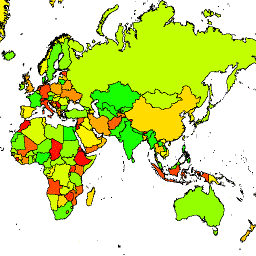AI-generated Key Takeaways
-
The USDOS/LSIB_SIMPLE/2017 dataset provides a simplified representation of large scale international boundaries as polygonal areas.
-
This dataset is a simplified version of the detailed 2013 LSIB dataset, with some disjointed regions reduced to a single feature and excluding smaller islands.
-
The data reflects U.S. government policies on boundaries, boundary disputes, and sovereignty.
-
The dataset is available for use with no restrictions as it is US public domain data.

- Dataset Availability
- 2017-03-30T00:00:00Z–2017-03-30T00:00:00Z
- Dataset Provider
- United States Department of State, Office of the Geographer
- Tags
Description
The United States Office of the Geographer provides the Large Scale International Boundary (LSIB) dataset. The detailed version (2013) is derived from two other datasets: a LSIB line vector file and the World Vector Shorelines (WVS) from the National Geospatial-Intelligence Agency (NGA). The interior boundaries reflect U.S. government policies on boundaries, boundary disputes, and sovereignty. The exterior boundaries are derived from the WVS; however, the WVS coastline data is outdated and generally shifted from between several hundred meters to over a kilometer. Each feature is the polygonal area enclosed by interior boundaries and exterior coastlines where applicable, and many countries consist of multiple features, one per disjoint region.
Compared with the detailed LSIB, in this simplified dataset some disjointed regions of each country have been reduced to a single feature. Furthermore, it excludes medium and smaller islands. The resulting simplified boundary lines are rarely shifted by more than 100 meters from the detailed LSIB lines. Each of the 312 features is a part of the geometry of one of the 284 countries described in this dataset.
Table Schema
Table Schema
| Name | Type | Description |
|---|---|---|
| abbreviati | STRING | Country abbreviation |
| country_co | STRING | |
| country_na | STRING | US-recognized country name |
| wld_rgn | STRING | Continental region, e.g. South America |
Terms of Use
Terms of Use
There are no restrictions on use of this US public domain data.
Explore with Earth Engine
Code Editor (JavaScript)
var dataset = ee.FeatureCollection('USDOS/LSIB_SIMPLE/2017'); var styleParams = { fillColor: 'b5ffb4', color: '00909F', width: 3, }; var countries = dataset.style(styleParams); Map.setCenter(16.35, 48.83, 4); Map.addLayer(countries, {}, 'USDOS/LSIB_SIMPLE/2017', true, 0.8);
Visualize as a FeatureView
A FeatureView is a view-only, accelerated representation of a
FeatureCollection. For more details, visit the
FeatureView documentation.
Code Editor (JavaScript)
var fvLayer = ui.Map.FeatureViewLayer('USDOS/LSIB_SIMPLE/2017_FeatureView'); var visParams = { color: '00909F', fillColor: 'b5ffb4', width: 3, opacity: 1 }; fvLayer.setVisParams(visParams); fvLayer.setName('USDOS/LSIB_SIMPLE/2017'); Map.setCenter(16.35, 48.83, 4); Map.add(fvLayer);